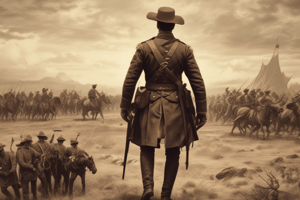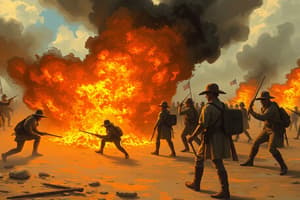Podcast
Questions and Answers
Which event is considered a turning point in U.S. history, marking the shift from isolationism to imperialism?
Which event is considered a turning point in U.S. history, marking the shift from isolationism to imperialism?
- Spanish-American War (correct)
- World War I
- American Revolution
- Civil War
The Monroe Doctrine was primarily aimed at preventing European intervention in the Americas.
The Monroe Doctrine was primarily aimed at preventing European intervention in the Americas.
True (A)
What is a protectorate?
What is a protectorate?
A protectorate is a state that is controlled and protected by another.
The __________ Amendment allowed for U.S. intervention in Cuban affairs.
The __________ Amendment allowed for U.S. intervention in Cuban affairs.
Match the following historical figures with their associated events or concepts:
Match the following historical figures with their associated events or concepts:
Which concept refers to the U.S. policy aimed at ensuring equal trading rights in China?
Which concept refers to the U.S. policy aimed at ensuring equal trading rights in China?
The Panama Canal was developed primarily for military shipping routes.
The Panama Canal was developed primarily for military shipping routes.
What was the primary motivation behind the U.S. annexation of Hawaii?
What was the primary motivation behind the U.S. annexation of Hawaii?
Flashcards
Imperialism
Imperialism
A policy of extending a nation's power and influence through diplomacy or military force, often by acquiring colonies or territories. This involved acquiring new territories and expanding a nation's power and influence.
Isolationism
Isolationism
A policy of national isolation, where a country chooses to limit its involvement in international affairs and avoids alliances or commitments to other nations.
Manifest Destiny
Manifest Destiny
A belief that the United States had a divine right and responsibility to expand across the North American continent from the Atlantic Ocean to the Pacific Ocean.
Protectorate
Protectorate
Signup and view all the flashcards
Assimilation
Assimilation
Signup and view all the flashcards
Colony
Colony
Signup and view all the flashcards
Dollar Diplomacy
Dollar Diplomacy
Signup and view all the flashcards
Roosevelt Corollary
Roosevelt Corollary
Signup and view all the flashcards
Study Notes
Key Figures
- William McKinley: President of the United States during the Spanish-American War.
- William Seward: Secretary of State who acquired Alaska for the US.
- Queen Liliuokalani: Last monarch of Hawaii, opposed to American annexation.
- Buffalo Soldiers: African American cavalry units in the Western expansion.
- Rough Riders: Volunteer cavalry unit led by Teddy Roosevelt in the Spanish-American War.
- Emilio Aguinaldo: Filipino leader who fought against U.S. annexation.
- Teddy Roosevelt: President who promoted "Big Stick" diplomacy and the Panama Canal.
- William Howard Taft: President who promoted "Dollar" Diplomacy.
- John Hay: Secretary of State who advocated for the Open Door Policy.
Key Terms & Concepts
- Colony: A territory under the direct political control of another country.
- Monroe Doctrine: U.S. policy opposing European colonization in the Americas.
- Yellow Journalism: Sensationalized news reporting that often exaggerated events.
- Imperialism: Extending a country's power and influence through diplomacy or military force.
- Propaganda: Ideas or information used to influence opinions or beliefs.
- Assimilation: The adoption of the cultural traits of another group.
- Foreign Affairs: Relationships and interactions with other countries.
- Annex: To incorporate a territory into a country.
- Isolationism: National policy of avoiding involvement in global affairs.
- Manifest Destiny: The belief that the US was destined to expand across North America.
- Sphere of Influence: Area where a foreign nation has significant economic and political power.
- Expansionism: Policy of territorial or economic expansion.
- Protectorate: A state that is protected by another, stronger, nation while maintaining some degree of independence.
- Territory: Area under the control of a country but not yet fully incorporated into it.
- Teller Amendment: Stated the US would not annex Cuba.
- Platt Amendment: Restricted Cuba’s autonomy, essentially making it an American protectorate.
- Panama Canal: An artificial waterway that connects the Atlantic and Pacific Oceans.
- Roosevelt Corollary: Extension of the Monroe Doctrine, authorizing US military intervention in Latin America.
- “Big Stick” Diplomacy: Using military strength to negotiate, thus making threats to get what the US wanted.
- “Dollar” Diplomacy: Using economic power to influence international relations.
- Spanish-American War: Conflict between Spain and the US, resulting in U.S. acquisition of territories.
- Philippine-American War: Conflict between the US and Filipino rebels, after the Spanish American War.
- Open Door Policy: Principle that all nations should have equal access to trade in China.
Big Ideas & Essential Questions
- Shift from Isolation to Expansionism: Factors such: Industrial growth, desire for new markets, new sources of raw materials, and a growing sense of national power drove the change. Manifest destiny fueled western expansion and a sense of national superiority.
- Spanish-American War's Significance: The war propelled the US onto the global stage as a major power, highlighted by the acquisition of important territories. The outcome fueled imperialism and annexation. Key causes were Yellow Journalism and the desire of the US to intervene. Key consequences were acquisition of overseas territories and the establishment of the US as a major imperial power.
- Philippine-American War: The US fought in the Philippines after the war to establish control of the islands, leading to fierce resistance from Filipinos under Aguinaldo. This conflict created a political division among Americans about imperialism.
- Arguments For and Against Annexation: Arguments for emphasized economic benefits, national prestige, and the "civilizing mission.” Arguments against highlighted the violation of self-determination, potential for conflict, and moral implications.
- Protectorate vs. Territory: A protectorate is a state controlled by a more powerful nation, while retaining some autonomy. A territory, a distinct category, is under the control but not part of the powerful nation's main state. Cuba became a protectorate under tight US influence.
- Motivations for Imperialism: Drive for new markets and resources, spreading political and economic ideologies, and national prestige.
- Advantages and Disadvantages of Imperialism: Advantages included economic opportunities, cultural exchange, and development in overseas territories. Disadvantages included exploitation of conquered peoples, political instability, and potential for conflict.
- Open Door Policy Significance: The policy ensured equal trade access for all nations in China. It was effective in preventing the partitioning of China. The Boxer Rebellion encouraged powers to agree.
- Acquisition of Hawaii and Alaska: Hawaii was annexed after a coup d'état by US businessmen and the US military involvement, despite Queen Liliuokalani's opposition. Alaska was acquired from Russia.
- Roosevelt Corollary and "Big Stick" Diplomacy: Extension of the Monroe Doctrine; the US would intervene in Latin American affairs to ensure stability and debt collection, strengthening U.S. influence and power.
- Panama Canal Significance: The canal facilitated trade routes and military deployment, strengthening US presence and influence in Latin America, exemplifying the US's growing imperialism.
Studying That Suits You
Use AI to generate personalized quizzes and flashcards to suit your learning preferences.




